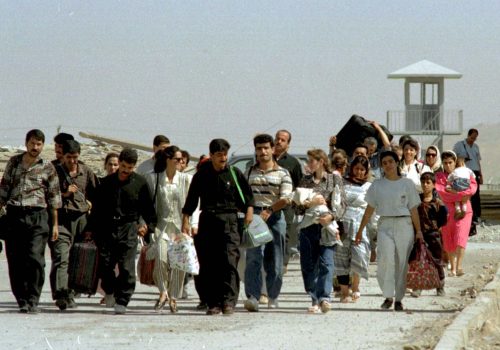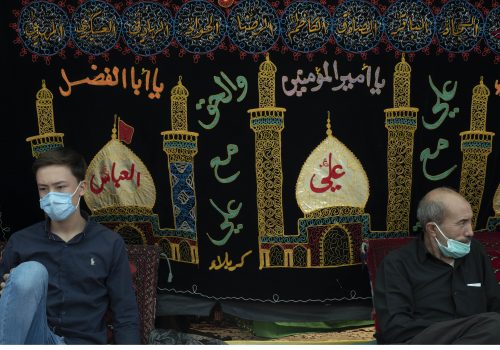It’s been twenty years since 9/11. The US Army still hasn’t learned to speak Arabic or Dari.
As the Taliban retook Afghanistan just as the United States completely departed the country on August 31, US military leaders seeking to better understand their faults should ask themselves a simple question: how well could I communicate with my security partners?
The August withdrawal ended close to twenty years of combat operations in Afghanistan, while the US aims to end seventeen years of combat mission in Iraq by the end of this year. After such lengthy conflicts, one might expect the US Army to be overrun with soldiers fluent in Arabic and Dari. Despite repeated deployments and enough time to educate current senior leaders in the ranks from grade school skills to bachelor’s degree-level, the overall rate of soldiers conversant in target languages remains abysmally low in combat arms, even among codified linguist positions.
While military leaders may lament nation-building and Counter Insurgency (COIN) operations, the fact remains that the army has always been at the forefront of such efforts. Even in operations where the US plans to forego such nation-building, stability operations remain a critical task for the army, as it maintains a monopoly on the conflict until a new security force is developed. Upon cessation of offensive operations, stability operations take priority to “maintain or reestablish a safe and secure environment and provide essential governmental services, emergency infrastructure reconstruction, and humanitarian relief.”
The language deficit
Despite updating the Language, Regional Expertise, and Culture (LREC) Program in 2016, the US military—the army in particular—is far behind the curve. The LREC Program assesses individuals who are novices with no local expertise to experts with native fluency. Despite infantry and armor formations making up the bulk of the deployed force over the years, anecdotally, most soldiers remain novices, as noted in a 2008 Congressional report. Despite this acknowledgement thirteen years ago, no meaningful changes have occurred. The lack of skills creates an information transfer choke point, where only a few leaders can interact with partners through an interpreter. Even the army’s Security Force Assistance Brigades (SFAB) do not train language skills. According to the former commander of the SFAB, Brigadier General Scott Jackson, the unit learns organizationally, not individually, how to advise partner nations, ensuring that no advisor gains skills in keeping with the LREC program.
For officers without previous experience in a region prior to commissioning, there is no available opportunity to develop regional proficiency. Infantry and armor officers—those that manage the bulk of the initial transition to stability operations—have no programmed regional proficiency education. Besides special forces officers, the opportunity to develop language and culture skills only occurs if an officer elects to become a foreign area officer, a career path outside of the typical “boots on the ground” environment. The Defense Language Aptitude Battery 2 is only administered at initial entry processing sites for those looking to join as linguists and on a prerequisite basis for application into the army special operations forces branches and foreign area officer program. No such requirement exists for infantry or armor branches—soldiers who will initially manage post-conflict stability operations.
The special forces branch puts a premium on language training but has shown troubling trends in its commitment to language development. According to a 2020 report, There is an Identity Crisis in Special Forces: Who are the Green Berets Supposed to Be?, 29 percent of special forces soldiers believed that language was not an important skill. Additionally, 62 percent did not practice their language regularly, 52 percent did not speak their target language on their most recent deployment, and 42 percent were not operating in a fashion that aligned with their assigned theater.
Director of the Atlantic Council’s Rafik Hariri Center and Middle East Programs, William Wechsler, and Director of the Modern War Institute, Dr. Liam Collins, attested to this language and cultural problem as a major cause of the army’s inability to make headway in irregular conflict. They argued that the only times advisor missions worked in the US’s favor is when the same advisors repeatedly deployed to the same theater.
Aforementioned, though regionally aligned, the SFAB receives no language training besides how to employ an interpreter. Reviewing the instruction program with the commander of the training course, it was confirmed that would-be advisors are not even briefed on campaign goals by the geographic combatant commands they will ultimately be aligned to. The military, as a whole, attempted a program similar to the SFAB during the Afghanistan war, focusing on repeated advisor deployments and language training with the AFPAK Hands Program. Bureaucratic resistance to the long training pipeline doomed the program to inefficiency and limited results.
Anecdotally, most combat arms personnel in the ranks are puzzled by the complete lack of investment in language skills despite repeated deployments to the same regions over the past twenty years. The current exfiltration crisis of Afghanistan interpreters draws attention to this issue. Nearly twenty thousand evacuated interpreters represent a brain drain of human capital that was used solely to enable American operations. This theft of intellectual services is a major concern of development projects but rarely seems to be part of the calculation for the army. Most retorts to this issue bring up programs like the Military Accessions Vital to National Interest. However, this program focuses on recruiting military interpreters and intelligence professionals, not combat arms soldiers. The program’s abysmal performance record limited its value and impact on operations.
Similarly, there is no real incentive to develop these skills amongst the other combat arms branches. The Army Strategic Language List for General Purpose Forces is a memorandum that identifies the required languages that the army currently pays a Foreign Language Proficiency Bonus (FLPB) for to provide to non-special operations forces. However, because of cost concerns, the FLPB is not paid universally, but is limited in eligibility for language specific assignments like foreign area officers or linguists. The Defense Language Proficiency Test (DLPT) is an annual requirement to maintain access to the bonus, which can range up to $500 per month for critical languages. Unfortunately, because the requirements exclude most combat arms job skills, an infantry captain who is a native Iraqi Arabic speaker has no incentive to take the DLPT. This inability to engage with all leaders of a partner force emphasizes engagement with partners that speak English since information transfer is easier, regardless of tactical competency compared to non-English speaking peers.
Looking ahead
Even if the US can avoid another major combat campaign in the near future, combined operations with multinational elements will remain. Dr. Mara Karlin, the current Assistant Secretary of Defense for Strategy, Plans and Capabilities, notes in her book, Building Militaries in Fragile States: Challenges for the United States, that many US advising efforts throughout the Cold War failed due to an over-reliance on becoming a co-combatant rather than being an astute observer and recommender of partner personnel and combat formation changes. This requires a keen grasp of the local culture, warfighting style, and host nation goals that cannot be readily understood through just an interpreter.
Nearly twenty years of continuous combat operations with a culturally deaf force has proven that the mirror-imaging US troops pushed onto their security partners caused grave blunders. As Robert Ramsey of the Combat Studies Institute points out in his summation of the American advisor experience in Korea, Vietnam, and El Salvador: “[i]t is almost impossible to find a complaint by any advisor in the three experiences surveyed who felt tactically, technically, or militarily unprepared for his duties…However, almost to a man, advisors felt compelled to talk about the demanding challenges posed by language, cultural differences, and host-nation institutional barriers.”
This is not just an army problem. According to a 2020 Council on Foreign Relations report, the State Department “still has more Portuguese speakers than Arabic and Chinese combined and more Albanian speakers than Urdu, Dari, or Farsi. Language-designated positions overseas are 15 percent vacant, and 24 percent of those staff are filled by officers who do not meet the minimum language requirement.” In short, even if the army thinks it can offload its responsibilities onto the State Department for stability operations, it has unrealistic expectations of inter-agency capabilities.
Despite all the literature of post-WWII army diplomacy, Cold War combat and advising operations, and now repeated COIN surges since 9/11, the US Army has still failed to learn the necessity of language and cultural skills amongst the combat arms force.
Jon Tishman is a former US Army infantry officer with multiple combat deployments to Iraq and Afghanistan. Follow him on Twitter: @tish_jon.
Image: Sergeant Jeffery Iburg from the US Army's Alpha Company, 2-508 Parachute Infantry Regiment, 4th Brigade Combat Team takes photos of a location during a patrol near Combat Outpost Kowall in Arghandab District, north of Kandahar July 13, 2010. REUTERS/Bob Strong


